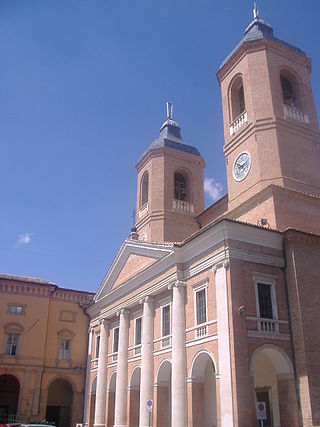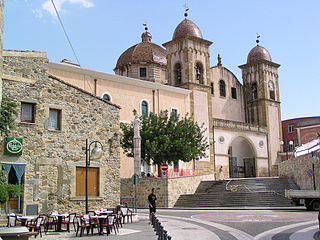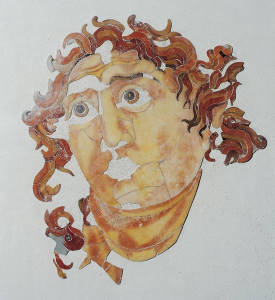
Mithraism, also known as the Mithraic mysteries or the Cult of Mithras, was a Roman mystery religion centered on the god Mithras. Although inspired by Iranian worship of the Zoroastrian divinity (yazata) Mithra, the Roman Mithras was linked to a new and distinctive imagery, and the level of continuity between Persian and Greco-Roman practice remains debatable. The mysteries were popular among the Imperial Roman army from the 1st to the 4th century CE.

The Basilica of Saint Clement is a Latin Catholic minor basilica dedicated to Pope Clement I located in Rome, Italy. Archaeologically speaking, the structure is a three-tiered complex of buildings: (1) the present basilica built just before the year 1100 during the height of the Middle Ages; (2) beneath the present basilica is a 4th-century basilica that had been converted out of the home of a Roman nobleman, part of which had in the 1st century briefly served as an early church, and the basement of which had in the 2nd century briefly served as a mithraeum; (3) the home of the Roman nobleman had been built on the foundations of republican era villa and warehouse that had been destroyed in the Great Fire of AD 64.

Tauroctony is a modern name given to the central cult reliefs of the Mithraic Mysteries in the Roman Empire. The imagery depicts Mithras killing a bull, hence the name tauroctony after the Greek word tauroktonos. A tauroctony is distinct from the sacrifice of a bull in ancient Rome called a taurobolium; the taurobolium was mainly part of the unrelated cult of Cybele.

The Italian Archdiocese of Camerino-San Severino Marche is a Latin diocese of the Catholic Church seated in Camerino, a city in the Province of Macerata, in the central Italian Marche region, in the Apennines. It is a suffragan of the Archdiocese of Fermo.

The Diocese of Brescia is a Latin diocese of the Catholic Church in the ecclesiastical province of the Metropolitan Archdiocese of Milan, in Lombardy.

Sant'Angelo in Pescheria or in Piscaria is a church in Rome. It dates from the 8th century. "In Pescheria" refers to its location close to the fish market built in the ruins of the ancient Porticus Octaviae.

The Italian Catholic diocese of Monopoli, in the province of Bari, existed from the eleventh century to 1986. In that year it was united into the diocese of Conversano-Monopoli.
The diocese of Nepi-Sutri was a Roman Catholic ecclesiastical territory in central Italy, created in 1435 by unifying the diocese of Nepi and the diocese of Sutri. It existed until 1986, when it was united into the current diocese of Cività Castellana.

The Diocese of Terni-Narni-Amelia is a Latin Church ecclesiastical territory or diocese of the Catholic Church in Umbria, central Italy. It was created in 1983, when the Diocese of Amelia was united with the Diocese of Terni and Narni. The latter had been in turn created in 1907, when the Diocese of Narni was united to the historical Diocese of Terni. The diocese is immediately exempt to the Holy See, not part of any ecclesiastical province.

The Diocese of Assisi-Nocera Umbra-Gualdo Tadino is a Latin diocese of the Catholic Church in Umbria, has existed since 1986. In that year the historic Diocese of Assisi, known as the birthplace of Francis of Assisi, was combined with the Diocese of Nocera Umbra-Gualdo Tadino. The diocese is a suffragan of the Archdiocese of Perugia-Città della Pieve.

The Diocese of Ales-Terralba is a Latin diocese of the Catholic Church located in Sardinia, Italy. It is a suffragan of the Archdiocese of Oristano.
The Roman Catholic Diocese of Santorini is a diocese of the Catholic Church located in the city of Santorini in the ecclesiastical province of Naxos, Andros, Tinos and Mykonos in Greece.
The Italian Catholic Diocese of Amelia, existed from the fifth century until 1983. In that year it was united into the new diocese of Terni, Narni, e Amelia. It was a suffragan of the archdiocese of Spoleto.
The former Italian Catholic Diocese of Città della Pieve, in Umbria, existed until 1986. In that year it was united into the Archdiocese of Perugia-Città della Pieve.
The former Italian Catholic diocese of Alatri existed until 1986, when it was united into the diocese of Anagni-Alatri. Comprising historically seven towns close to Rome, it was under the immediate jurisdiction of the Holy See.
The Roman cult of Mithras had connections with other pagan deities, syncretism being a prominent feature of Roman paganism. Almost all Mithraea contain statues dedicated to gods of other cults, and it is common to find inscriptions dedicated to Mithras in other sanctuaries, especially those of Jupiter Dolichenus. Mithraism was not an alternative to other pagan religions, but rather a particular way of practising pagan worship; and many Mithraic initiates can also be found worshipping in the civic religion, and as initiates of other mystery cults.
The Archbishopric of Damascus is a Roman Catholic titular see located in Damascus, Syria.
The Diocese of Umbriatico was a Roman Catholic diocese located in the town of Umbriatico in the province of Crotone in southern Italian region of Calabria. In 1818, it was suppressed with the bull De utiliori of Pope Pius VII, and incorporated in the diocese of Cariati.
The Roman Catholic Archdiocese of Nazianzus is a titular see of the Catholic Church. Both Western Catholic and the Eastern Catholic bishops have been assigned to this diocese. The most famous of which being Saint Gregory of Nazianzus.

The Mithraeum of Dura Europos was found during excavations in the city in 1934. It is considered to be one of the best-preserved and best-documented cult buildings of Mithraism.


















